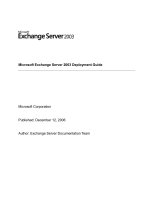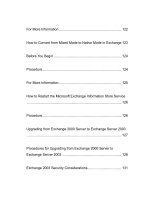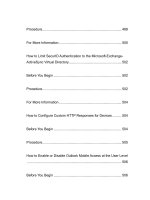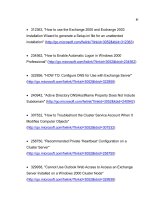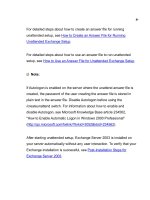Microsoft Exchange Server 2003 Deployment Guide- P34 docx
Bạn đang xem bản rút gọn của tài liệu. Xem và tải ngay bản đầy đủ của tài liệu tại đây (186.03 KB, 10 trang )
331
Figure 2 illustrates the four-node, active/passive Exchange Server 2003
cluster.
Figure 2 Four-node active/passive Exchange Server 2003 cluster
The following sections provide the recommended software, hardware,
and storage requirements for an Exchange Server 2003 active/passive
four-node cluster.
332
Software Recommendations
In this scenario, all four nodes in the cluster are running Windows
Server 2003, Enterprise Edition and Exchange Server 2003, Enterprise
Edition. Additionally, each node is connected to a DNS server configured
for dynamic updates.
Hardware Recommendations
In this scenario, the following hardware configurations are recommended.
Server hardware
Four 1 gigahertz (GHz), 1 megabyte (MB) or 2 MB L2 cache
processors
4 gigabytes (GB) of Error Correction Code (ECC) RAM
Two 100 megabits per second (Mbps) or 1000 Mbps network interface
cards
RAID-1 array with two internal disks for the Windows Server 2003 and
Exchange Server 2003 program files
333
Two redundant 64-bit fiber Host Bus Adapters (HBAs) to connect to the
Storage Area Network
Local area network hardware
Two 100 Mbps or 1000 Mbps network switches (full duplex)
Storage Area Network hardware
Redundant fiber switches
106 disk spindles (Ultra Wide SCSI) with spindle speeds of 10,000
RPM or greater
256 MB or more read/write cache memory
Storage Configuration Recommendations
In this scenario, the following storage configurations are recommended:
Storage groups and databases
Three storage groups per Exchange Virtual Server
334
Five databases per storage group
Disk drive configuration
Table 2 lists the recommended disk drive configuration. For more
information about this and other disk drive configurations, see "Drive
Letter Configurations" in the guide Planning an Exchange Server 2003
Messaging System (
Table 2 Disk drive configuration for a four-node active/passive
cluster containing three Exchange Virtual Servers
Node 1 (EVS1
active)
Node 2 (EVS2
active)
Node 3 (EVS3
active)
Node 4
(passive)
Disk 1:
SMTP/MTA
Disk 8: SMTP Disk 15: SMTP Disk 22: Quorum
Disk 2: SG1
databases
Disk 9: SG1
databases
Disk 16: SG1
databases
Disk 3: SG1 logs
Disk 10: SG1
logs
Disk 17: SG1
logs
335
Node 1 (EVS1
active)
Node 2 (EVS2
active)
Node 3 (EVS3
active)
Node 4
(passive)
Disk 4: SG2
databases
Disk 11: SG2
databases
Disk 18: SG2
databases
Disk 5: SG2 logs
Disk 12: SG2
logs
Disk 19: SG2
logs
Disk 6: SG3
databases
Disk 13: SG3
databases
Disk 20: SG3
databases
Disk 7: SG3 logs
Disk 14: SG3
logs
Disk 21: SG3
logs
Storage Area Network disk configuration
SMTP/MTA drives RAID-(0+1) array consisting of four spindles. (3
EVSs × 4 disks = 12 disks.)
336
Storage group log drives RAID-1 array consisting of two spindles.
(3 EVSs × 3 storage groups × 2 disks = 18 disks.)
Database (.edb and .stm files) drives RAID-(0+1) array consisting
of eight spindles. (3 EVSs × 3 storage groups × 8 databases = 72 disks.)
Quorum disk resource drive RAID-1 array consisting of two
spindles (2 disks).
Total shared disk spindles is 104.
Deploying a New Exchange Server 2003 Cluster
This section provides information about how to deploy a new Exchange
Server 2003 cluster in your organization. The procedures referenced this
section are applicable for any cluster configuration, from an
active/passive cluster with two to eight nodes to a two-node active/active
cluster with one or two nodes.
Specifically, this section will guide you through the following steps:
1. Preparing Active Directory for Exchange Server 2003.
337
2. Installing Exchange Server 2003 on each node.
3. Creating the Exchange Virtual Servers.
Step 1: Preparing Active Directory for Exchange Server 2003
Preparing Active Directory for a cluster installation resembles preparing
Active Directory for non-clustered servers.
Step 1 includes the following tasks:
1. Run ForestPrep.
2. Run DomainPrep.
Running ForestPrep
Before you install Exchange Server 2003 anywhere in the forest, you
must extend the Windows Active Directory schema. To accomplish this
task, you must run ForestPrep.
338
Note:
Running ForestPrep is required only if you are installing Exchange
Server 2003 for the first time in your organization. If you already
installed Exchange Server 2003 in your organization, you do not have
to run ForestPrep.
For detailed steps about how to run ForestPrep, see How to Run
Exchange Server 2003 ForestPrep.
Note:
During the ForestPrep process, you will enter the name of the user or
group who is responsible for installing Exchange Server 2003. This
account must be a domain account that includes local administrator
privileges on the cluster nodes. The account you specify will also have
permission to use the Exchange Delegation Wizard to create all levels
of Exchange Server 2003 administrator accounts.
Running DomainPrep
You must run DomainPrep for each Windows 2000 or Windows
Server 2003 domain in which you want to install Exchange Server 2003.
339
However, before you can run DomainPrep, ForestPrep must finish
replicating the schema updates.
Note:
Running DomainPrep is required only if you are installing Exchange
Server 2003 for the first time in your domain. If you already installed
Exchange Server 2003 in your domain, you do not have to run
DomainPrep.
For detailed steps about how to run DomainPrep, see How to Run
Exchange Server 2003 DomainPrep.
Step 2: Installing Exchange Server 2003 on Each Node
After you extend the schema with ForestPrep and prepare the domain
with DomainPrep, you are ready to install Exchange Server 2003 on the
first cluster node.
Step 2 includes the following tasks:
1. Make sure that the Cluster service is running on each node.
2. Install and enable the required Windows services.
340
3. Install Microsoft Distributed Transaction Coordinator (MSDTC).
4. Run Exchange Server 2003 Setup.
However, before you perform these tasks, familiarize yourself with the
requirements necessary for installing Exchange Server 2003 on cluster
servers (Table 3).
